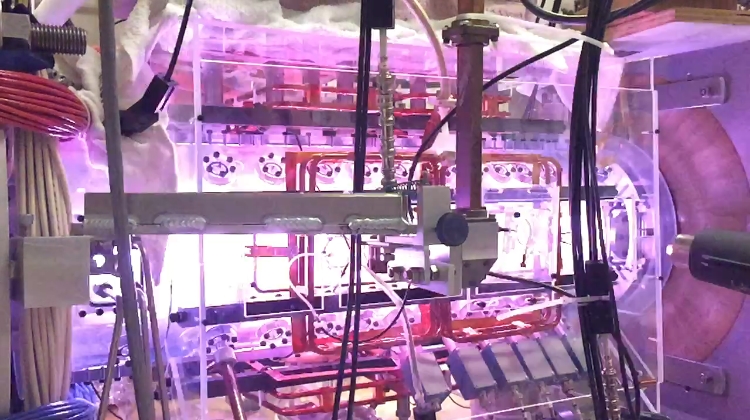PFRC_2_pulse.jpg

Part 6 of 6 Parts (Please read Part 1, 2, 3, 4 and 5 first)
Cohen has been working on his Princeton Field Reversed Configuration (PFRC) design since 2002. He places great importance on simplicity and compactness. The cylindrical plastic chamber of his current prototype labeled PFRC-2 is only about a yard long. There are no plasma cannons or neutral beam injectors. Instead, the FRC is generated by a technique first investigated by Austrian and Australian physicists and refined by Cohen.
Cohen has four rectangular copper coils that surround the middle of the tube, one each for its front, back, top and bottom. Each rectangle is divided into two smaller rectangles. The basic concept of the arrangement is to drive oscillating currents through these coils in a way that sets up a rotating magnetic field inside the tube. A loop of flux whirls around through the plasma and drags the plasma particles around and around in the center of the cylinder. Cohen says that “the fields create, stabilize, and heat the FRC.”
Cohen routinely demonstrates the basic concept in his lab. Every two second, the hydrogen plasma is spun into a FRC which causes a flash of light. Each flash lasts for about eight milliseconds because extending the flash any longer risks melting the cables that supply the magnetic coils with power. He says that they have to make better cables which will allow them to keep the FRC going indefinitely.
In the meantime, Cohen and his team are working on the main goal of the PFRC-2 prototype which is to improve the ability of the magnetic coils to heat the plasma. Binderbauer says, “I know Sam well, we root for each other. But his plasma are cold.” He goes on to say that it still remains to be seen whether or not the rotating magnetic fields approach will work in a full-scale fusion reactor. He said, “I'm not trying to say that it can't be done, but I think those are some of the things that they're going to have to address.”
Cohen remains confident about the TAE approach. If things go as planned in the next few years, the PFRC-2 will be replaced by the PFRC-3 which will be twice as big. This new machine should allow them to keep FRCs going for up to ten seconds with plasma temperatures as high as sixty million degrees Kelvin. A few years after that, the plan calls for developing the PFRC-4 which will be even larger and will be designed to use live fusion fuel at temperatures of six hundred million degrees Kelvin.
The fuel that will be burned in the PFRC-4 will be deuterium-helium-3 which Cohen calls the “Goldilocks approach” between deuterium-tritium and proton-boron-11. Helium-3 is extremely rare on Earth although a tiny amount is produced during natural gas extraction and during the operation of nuclear fission reactors. It is possible to make and capture helium-3 from the fusing of deuterium-helium but Cohen and his team will not attempt it at this stage. He feels that there will be enough helium-3 available to use for powering spacecrafts with his fusion engine.
It will be another ten to fifteen years before PFRC-based fusions reactors are reliable enough to sustain a multi-year deep-space mission, assuming that they work at all. But, the same thing could be said about any of the alternative nuclear fusion reactor designs currently being worked on.
Princeton Field Reversed Configuration 2